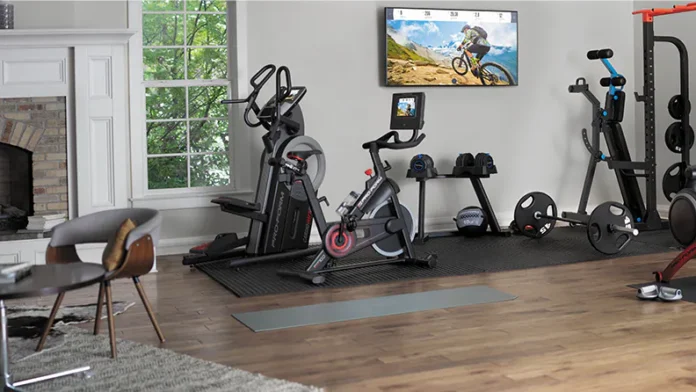The significance of suitable flooring cannot be overstated in the realm of fitness and exercise spaces. Whether it’s a home gym, a commercial fitness centre, or a sports facility, the right flooring enhances the aesthetics and plays a crucial role in ensuring safety, durability, and performance. Among the myriad options available, gym flooring tiles are popular due to the versatility, durability, and ease of installation. Below is the guide to select quality gym flooring tiles for the ultimate workout space.
Understanding Gym Flooring Tiles
Gym floor tiles are designed to withstand heavy equipment rigours, high-impact activities, and constant foot traffic. Made from various materials such as rubber, foam, or PVC, these tiles offer a resilient surface that absorbs shock, reduces noise, and provides traction for a safe workout environment. Gym flooring tiles cater to diverse preferences and functional requirements and are available in an array of sizes, thicknesses, colours, and textures.
Key Factors to Consider
When choosing gym flooring tiles, several factors should influence your decision to ensure you get the most suitable option for your space:
- Material: Selecting the suitable material is paramount as it determines the flooring’s durability, comfort, and maintenance. Rubber tiles are renowned for their durability and shock-absorbing properties, making them ideal for high-traffic areas and heavy equipment. Foam tiles offer excellent cushioning and are lightweight, making them suitable for aerobics and yoga studios. PVC tiles provide a budget-friendly option with easy maintenance but may not offer the same level of durability as rubber.
- Thickness: The thickness of the tiles impacts their shock-absorption capabilities and durability. Thicker tiles offer better protection against heavy impacts and enhance support for heavy equipment. However, thinner tiles are more suitable for areas with low-impact activities or where space constraints are a concern.
- Interlocking vs. Non-Interlocking: Gym flooring tiles are available in interlocking and non-interlocking designs. Interlocking tiles feature puzzle-like edges that fit together seamlessly, offering easy installation without adhesive need. Non-interlocking tiles require adhesive for installation but provide a smoother surface without visible seams.
- Surface Texture: The texture of the tiles influences traction and grip, especially in the areas prone to moisture or sweat. Opt for tiles with textured surfaces or patterns that enhance grip and reduce risk of slips and falls.
- Durability and Maintenance: Consider durability of the tiles in terms of anticipated usage and maintenance requirements. High-quality rubber tiles resist wear, tear, and moisture, requiring minimal maintenance and long-term durability. Foam and PVC tiles may require frequent replacement and maintenance, especially in high-traffic areas.
Benefits of Gym Flooring Tiles
Investing in quality gym flooring tiles offers numerous benefits for both fitness enthusiasts and facility owners:
- Safety: Gym flooring tiles provide a cushioned surface which reduces the compliance of injuries from falls and impacts, making them ideal for high-intensity workouts and athletic activities.
- Durability: Quality tiles are designed to withstand demands of heavy equipment, constant foot traffic, and vigorous workouts, ensuring long-term performance and durability.
- Noise Reduction: The resilient properties of gym flooring tiles help absorb impact and reduce noise, creating a quieter and more comfortable workout environment for users and minimising disturbances to neighbouring spaces.
- Versatility: Gym flooring tiles are suitable for various applications, including weight rooms, cardio areas, aerobics studios, and multipurpose fitness spaces, offering versatility and adaptability to different workout requirements.
- Easy Installation and Maintenance: Interlocking gym flooring tiles can be installed without professional assistance, saving time and labour costs. Additionally, the low maintenance requirements of quality tiles make them a convenient choice for busy fitness facilities.
Maximising Performance with Quality Gym Flooring Tiles
Customisation Options
Another aspect to consider when selecting gym floor tilesis customization options. Many manufacturers offer customization services, allowing you to personalise your gym flooring to match your brand aesthetic or design preferences. Customisation options may include choosing specific colours, adding logos or graphics, or creating unique patterns and designs. Customised gym flooring not only enhances the visual appeal of your space but also reinforces your brand identity and creates a professional atmosphere for clients and members.
Environmental Considerations
In today’s environmentally conscious world, sustainability is crucial when choosing gym flooring tiles. Look for tiles made from recycled materials or those manufactured using eco-friendly processes. Additionally, select products free from harmful chemicals such as phthalates, lead, and PVC, ensuring a safe and healthy environment for users. Investing in environmentally friendly gym flooring demonstrates your commitment to sustainability and contributes to a greener, more sustainable future for the fitness industry.
Selecting suitable gym flooring tiles is essential for creating a safe, comfortable, high-performance workout space. Consider material, thickness, interlocking design, surface texture, durability, and maintenance requirements to choose tiles that meet your specific needs and preferences. With quality gym flooring tiles, you can enhance your fitness or exercise facility’s functionality, aesthetics, and safety, providing users with an ultimate workout experience.


